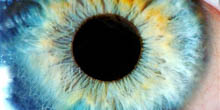Dolphins, Owls, and Other Animals with Better Vision Than You

In terms of evolutionary development, it can be easy to assume humans always come out on top. After all, our opposable thumbs allowed us to make tools millions of years ago; our large brains have helped us to make incredible developments in technology and engineering; and our ability to use complex language permits us to form lasting and fruitful relationships with others.
But the truth is, some aspects of our development are simply, well, underdeveloped when compared with some other species. Take our vision, for example.
Comparing Vision in the Animal Kingdom
Sure, we can see the world around us pretty clearly. Even those of us with refractive errors such as myopia (short-sightedness), hyperopia (long-sightedness) and astigmatism have the opportunity to see clearly, thanks to the development of visual aids (another unique development of humans).
We can perceive a fairly impressive range of the colour spectrum, we can see stars that are millions of light-years away, and, at the same time, pick up details as small as 0.1 millimetres (unfortunately, including those tiny wrinkles around our eyes).
The fact is, every animal on Earth has adapted to their particular environment and survival needs. So, it’s difficult to say that one species’ vision is ‘better’ than another. However, objectively speaking, there are a number of animals that could be said to outdo us when it comes to vision quality and range.
Take the leaf-tailed gecko, for example. These small reptiles have vertical pupils with a series of tiny “pinholes” that widen at night. This allows for incredible night vision – around 350 times better than that of humans!
It might also surprise you to learn that goats, while often appearing somewhat dim, also have an impressive visual development. Their rectangular pupils allow for an up to 340-degree field of vision, meaning that while they are looking down while grazing, they could still be looking right at you!
So, with all this in mind, let’s take a closer look at some of the incredible visual wonders of the animal kingdom. We’ll explore some of the most effective animal eyes and see how our own vision stacks up.
Eagles
The term “eagle-eyed” is often used to describe someone with particularly good attention to detail, and when you take a closer look at the vision of an eagle, it is easy to see why.
With eyesight estimated to be between four and eight times stronger than that of a human, birds of prey such as eagles and falcons may well have some of the most efficient eyes in the animal world. Some studies indicate that, if a person’s visual acuity was as strong as an eagle’s, it would mean having 20/4 resolution – five times greater than “average” vision.
Don’t get us wrong, all birds of prey are known to have excellent vision – it is essential for avoiding collisions and spotting prey while flying at high speeds. But the vision of eagles, in particular, stands out.
It is said that an eagle can spot a rabbit from a distance of 3.2 km! What’s more, an eagle’s powerful eyes allow it to zoom in on and shift focus on an object as it flies, not to mention its perception of a wider range of colours!
Owls
Before moving on from birds of prey, it would be remiss not to mention owls. All types of owls are known for their exceptional vision, particularly at night. It is these birds that reign supreme over the skies once the sun goes down.
Having large eyes and a high concentration of rods (light-sensitive cells), owls are particularly well-suited to hunting in low-light conditions, which is just as well since most owl species are nocturnal! But many species of owls can also see well during the day. And with such big eyes to worry about, they have three eyelids to protect them from the sun!
While most birds have eyes that sit at an angle towards the sides of their heads, allowing a wider scope of vision, owls’ eyes face directly forward. What’s more, owls don’t have eyeballs which can move around independently of the head. Rather, they have elongated, tube-shaped eyes that are held in place by structures called sclerotic rings.
On first glance, this might seem like a disadvantage, until you consider perhaps the most well-known ability of owls: They can turn their heads nearly all the way around! This allows for 270 degrees of vision, or more, without the need to move their bodies. As such, owls have excellent binocular vision.
Mantis Shrimp
Eagles might have impeccable distance vision, and owls may be able to spot minute details even at night, but the mantis shrimp may well take the crown for the most complex eyes on the planet.
As we mentioned earlier, we humans are able to perceive a fairly diverse range of colours. Our eyes have three types of cones, which allow us to perceive colours on the spectrum from red through to violet. But in comparison, with sixteen types of cones, the vision of a mantis shrimp allows them to perceive ultraviolet and infrared wavelengths.
However, some research shows this doesn’t necessarily mean that this aquatic crustacean perceives the world in a fantastical array of unimaginable colours. Rather, it suggests they can notice minute changes in colour almost instantaneously. This may prove beneficial in detecting changes to their environments, such as the presence of predators.
Moreover, the eyes of a mantis shrimp move independently and feature three “pseudo-pupils”, stacked one on top of the other. These features further contribute to the creatures’ impressive vision, making them formidable predators.
Dolphins
Dolphins are well-known for many things. including their intelligence and social awareness. They have been known to save humans stranded at sea, even appearing to guide people away from danger (including sharks). They are also known to have excellent hearing and to use echolocation to navigate the ocean. But a lesser-known asset these well-loved sea mammals enjoy is their vision.
The location of dolphins’ eyes, laterally, on the sides of their heads, means that they can move independently, offering 300-degree panoramic vision. In comparison, human eyes, which are placed parallel on the front of the head, provide us with around 180 degrees of vision.
The brain of a dolphin can process two separate visual fields at the same time. This is a fantastic advantage when considering the vastness of their environment!
We may not be able to give you the vision of an eagle or a dolphin, but Laser Eye Surgery could unlock your best-corrected vision, without glasses or contact lenses! Get in touch with one of our friendly clinic coordinators or Book a Consultation today to see if you could be suitable for treatment.


